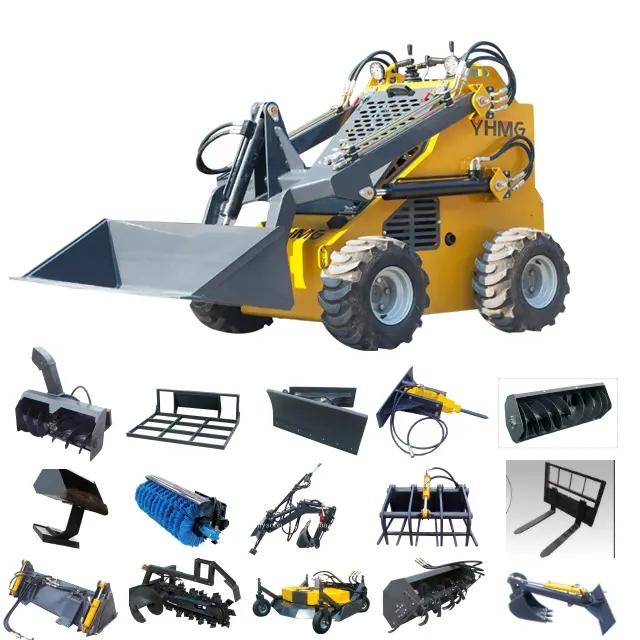In the dynamic world of construction, efficiency, safety, and cost-effectiveness are paramount. Among the myriad of equipment that drive this industry forward, the sliding loader has making it an indispensable assistant for many construction units. This versatile machine has revolutionized construction processes by enhancing productivity and reducing downtime.

What is a Sliding Loader?
A sliding loader, also known as a telehandler or telescopic handler, is a heavy-duty machine primarily used for material handling and lifting tasks in construction sites. It features an extendable boom that can reach high and distant areas, coupled with a versatile attachment system that allows it to perform multiple functions such as loading, unloading, lifting, and even digging. Its defining characteristic is the ability to slide its load along its boom, providing unprecedented flexibility and precision in handling materials.
Efficiency and Productivity Boost
1. Versatile Attachments for Diverse Tasks
One of the key advantages of sliding loaders lies in their ability to accommodate a wide range of attachments. From buckets and forks to winches and man baskets, these attachments enable the loader to perform a multitude of tasks seamlessly. This versatility translates into significant time savings as contractors no longer need to switch between different machines for various operations, thereby boosting overall site productivity.
2. Enhanced Reach and Maneuverability
The extendable boom of a sliding loader offers unparalleled reach and maneuverability, making it ideal for working in tight spaces or accessing hard-to-reach areas. This feature is particularly beneficial in urban construction projects where space is at a premium. By minimizing the need for additional equipment or complex logistics, sliding loaders streamline operations and expedite project timelines.
Cost Savings and Economic Benefits
1. Reduced Labor Costs
The automated and mechanized nature of sliding loaders reduces the reliance on manual labor. This not only mitigates the risks associated with manual handling but also cuts down on labor costs. With fewer workers needed for heavy lifting and material handling, construction companies can reallocate resources towards other critical areas, further enhancing project efficiency.
2. Lower Maintenance and Operational Costs
Despite their sophisticated design, sliding loaders are known for their reliability and durability. Modern models incorporate advanced technology and robust materials that minimize downtime due to breakdowns. Moreover, the versatility of these machines means fewer specialized pieces of equipment are required, leading to lower overall maintenance and operational costs.
Safety and Compliance
1. Improved Safety Standards
Safety is a paramount concern in any construction environment. Sliding loaders are designed with operator safety in mind, featuring ergonomic cabs, advanced stability controls, and comprehensive operator training programs. By automating hazardous tasks and reducing the need for workers to engage in physically demanding activities, these machines contribute to a safer worksite.
2. Compliance with Regulatory Requirements
With stringent health and safety regulations continually evolving, construction companies must ensure their operations comply with the latest standards. Sliding loaders, with their cutting-edge safety features and compliance certifications, help businesses meet these requirements, minimizing legal risks and safeguarding their reputation.
Environmental Impact and Sustainability
1. Reduced Carbon Footprint
The efficient use of sliding loaders leads to decreased fuel consumption and emissions compared to traditional methods. By consolidating multiple functions into a single machine, these loaders contribute to more environmentally friendly construction practices. This aligns with the growing trend towards sustainable building and supports efforts to reduce the industry's carbon footprint.
2. Promoting Recycling and Reuse
The versatility of sliding loaders also extends to handling recyclable materials. In demolition and renovation projects, these machines can efficiently sort and load debris for recycling, promoting waste reduction and resource conservation.
Conclusion
The importance of sliding loaders in the construction industry cannot be overstated. Their unique blend of versatility, efficiency, cost-effectiveness, safety, and environmental benefits makes them indispensable assets for modern construction firms. As technology continues to advance, PABREAK sliding loaders will undoubtedly play an even more crucial role in shaping the future of construction, driving innovation, and enhancing the overall performance of construction projects worldwide. By embracing this technology, contractors can stay ahead of the competition, ensuring their operations remain productive, safe, and sustainable.
https://www.skidsteerpabreak.com/importance-of-sliding-loader-in-construction-industry.html

